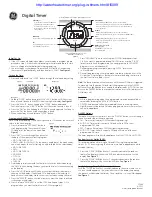
UT5A
7
low (approximately 0VDC). The Low appears at J4 pin 1 as the Non-inverted
Timer Output.
If U1’s pin3 output is High, the base of Q2 is High, causing it to be turned on.
This pulls Q2’s collector Low, and this Low (approximately 0VDC) is applied to
J5 pin2 as the Inverted Timer Output. If JMP7 is installed, this Low
(approximately 0VDC) is applied to the base of Q3, turning it off. This allows
pull-up resistor R12 to pull Q3’s collector High (approxiV). The High
appears at J4 pin 1 as the Non-inverted Timer Output.
The Inverted Timer Output at J5 pin2 and Non-Inverted Timer Output at J4
pin1 can be used as logic level outputs. A Low is less than 200mV and a
High is from +3 to +24V, depending on the supply voltage used for V+. They
also can be used to drive a load of up to 200mA if the load is connected
bV pin at J4 pin2 and either of the Timer Output pins. To have the
load active when the timer’s output at U1 pin3 is High, connect the load
between J4 pin2 and J5 pin2. To have the load active when the timer’s output
at U1 pin3 is Low connect the load between J4 pin2 and J4 pin1. D3 and D4
protect Q2 and Q3 respectively from inductive kick if an inductive load is used.
MODES OF OPERATION
Note: For these explanations we will assume no Control Voltage input. Only
basic operation is covered here.
Monostabe Mode:
In Monostable mode the timer acts as a “one shot” pulse generator. It has
one Stable and one Unstable state. The pulse begins with a negative input
trigger. This causes the output of the 555 timer to go from low to high starting
the pulse (Unstable). The Pulse Width is determined by the charging
network’s RC time constant. When the circuit times out the output of the 555
timer goes from high to low completing the pulse (Stable). The timer will
remain in this Stable state until it is triggered again.
In Monostable mode the 555 timer requires an external negative pulse or
spike to start its operation. We will be using the pulse provided by the Input,
Differentiator, and Limiter circuit previously described. This means JMP4
(Input Select) must be installed.
JMP6 (Mode Select) set to pins 1 and 2 prepares the Charging Network for
Monostable operation. The C2’s charge path can be traced by starting at
+VCC down through R4, R5, to the pin7 (Discharge) of the timer IC, through
JMP6 pin1 to pin2, to C2. You may notice that R6 and R7 are bypassed in
this mode. C2 is also directly connected to pin6 (Threshold) of the timer IC.
When C2 is charging the Monostable is in its Unstable state. C2 is allowed to
charge when U1 pin3 (Output) is High and pin7 (Discharge) is providing an








































